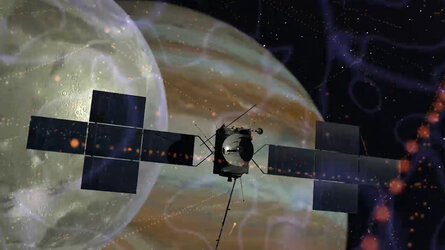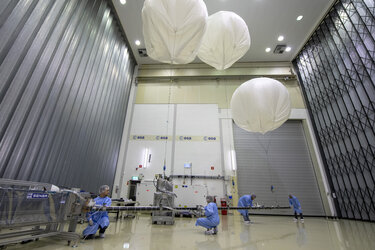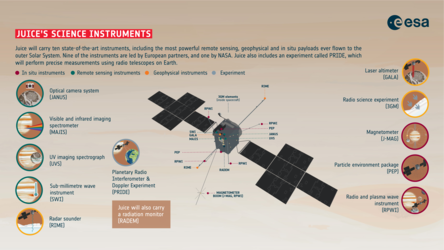

Juice magnetometer fit to take data
The magnetometer instrument on the Jupiter Icy Moons Explorer (Juice) spacecraft has been rigorously tested and is ready to fulfil its mission.
The magnetometer instrument (J-MAG), led by Imperial College London researchers, consists of three sensors, all of which were shown to be operating well. The deployment also marks the first time a quantum interference sensor – a precise but delicate technology – has been used beyond Earth orbit.
The J-MAG instrument will be crucial for Juice’s mission to characterise the oceans expected to be found beneath the outer icy crusts of three of Jupiter’s moons – Ganymede, Callisto and Europa – and determine whether they might be able to support life.
Although Juice will take around eight years to get to the Jupiter system, the early testing success of the instrument is an important milestone for the feasibility of the mission.
J-MAG principal investigator Professor Michele Dougherty, from the Department of Physics at Imperial, said: “It is a great relief that all three sensors are healthy and operating well after launch and so exciting to see them all measuring the magnetic field together.”
A new kind of sensor
J-MAG consists of three sensors – one built at Imperial College London, one built at the Technische Universität Braunschweig, Germany, and one built at the Austrian Academy of Sciences (OeAW) in partnership with Graz University of Technology, Austria.
The Imperial and Braunschweig instruments are ‘fluxgate’ sensors, which can measure the direction and strength of magnetic fields. They are labelled ‘outboard’ (MAGOBS) and ‘inboard’ (MAGIBS) sensors respectively, separated by about three metres with MAGOBS mounted close to the end of a 10.6-m boom to isolate it from the influence of the spacecraft.
Fluxgate sensors require regular calibration in-flight. The magnetic environment around Ganymede is so complicated and changing so rapidly that traditional calibration techniques for fluxgates – such as rolling the spacecraft at Ganymede – will not work. So, a new calibration method was needed using a sensitive and accurate quantum sensor, labelled MAGSCA.
MAGSCA, built in Austria and located at the tip of the boom, measures the absolute strength of the magnetic field. It uses the Zeeman effect, which causes a splitting of electron energy levels in proportion to the strength of the magnetic field. The quantum effect is generated by specifically modulated laser light interfering with rubidium atoms in the glass cell of the MAGSCA sensor.
This measurement is free from calibration errors because the effect is based on fundamental physical constants. The MAGSCA sensor calibrates the other two, so they can fully characterise the magnetic field.
Lead co-investigator on MAGSCA at the Space Research Institute of OeAW, Werner Magnes, said: “Developing this new technology for the Jupiter mission was a big challenge for the entire J-MAG team, which received great support from ESA and Airbus. We are very happy that MAGSCA now works perfectly in space.”
Successful measurement
This plot represents the very first detection of the quantum interference signal to measure magnetic fields in the MAGSCA sensor on the Juice spacecraft, now five million kilometres away from Earth. It shows the magnetic field along the SCA optical axis for all three sensors (IBS and OBS field are projected onto that axis). The OBS and SCA field are shifted with respect to IBS to aid visualisation.
It can be seen in the plot that the three J-MAG sensors are tracking the same variations in the solar wind magnetic field, confirming the good performance of all three sensors.
Originally published by Imperial College London.
About Juice
Juice is humankind’s next bold mission to the outer Solar System. After an eight-year journey to Jupiter, it will make detailed observations of the gas giant and its three large ocean-bearing moons: Ganymede, Callisto and Europa. This ambitious mission will characterise these moons with a powerful suite of remote sensing, geophysical and in situ instruments to discover more about these compelling destinations as potential habitats for past or present life. Juice will monitor Jupiter’s complex magnetic, radiation and plasma environment in depth and its interplay with the moons, studying the Jupiter system as an archetype for gas giant systems across the Universe.





